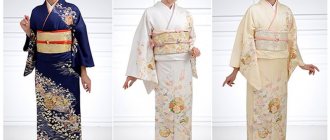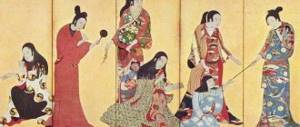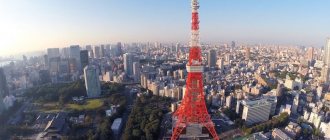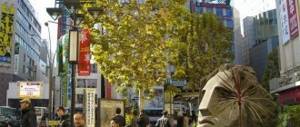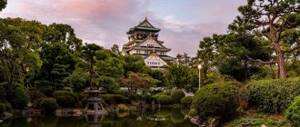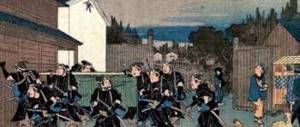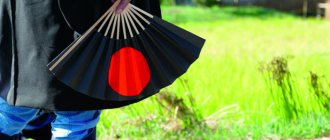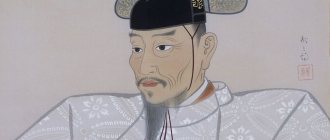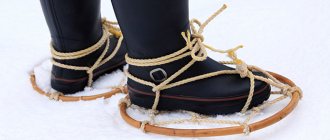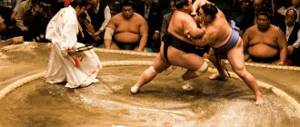The traditional Japanese helmet is considered to be the Kabuto. It was usually shaped like a hemisphere and consisted of several metal plates or leather, and in some cases the helmets were made from a combination of these two materials. On the back of the kabuto, curved plates connected to each other with ribbons were attached, which acted as protection for the ears and neck. Like many Japanese military equipment, the helmet of the medieval Japanese samurai was intended not only for protection in battle, but also to determine the warrior’s status in society.
Ancient armor
Samurai armor couldn't have come out of nowhere. It had an important predecessor-prototype - the tanko, which was used until the 8th century. Translated from Japanese, this word means “short armor”. The basis of the tanko was an iron cuirass, consisting of individual metal strips. Outwardly, it looked like a primitive leather corset. The tanko was held on the warrior’s body thanks to a characteristic narrowing at the waist.
This armor embodied many ideas that were developed in the Middle Ages in the form of classic samurai armor. But there were also primitive shortcomings in the tanko. Thus, the design features did not allow it to be used in equestrian combat, since sitting on a horse in such attire was extremely uncomfortable. In addition, this armor did not have greaves.
O-yoroi
The originality that distinguished samurai armor arose for many reasons. The primary one was Japan's isolation from the outside world. This civilization developed quite separately even in relation to its neighbors - China and Korea. A similar feature of Japanese culture was reflected in the national weapons and armor.
Classic medieval armor in the Land of the Rising Sun is considered o-yora. This name can be translated as “great armor.” By its design, it belonged to the lamellar (that is, plastic type). In Japanese, such armor was generally called kozan-do. They were made from intertwined plates. The starting material was thick tanned leather or iron.
Features of lamellar armor
Plates were the basis of almost all Japanese armor for a very long time. True, this fact did not negate the fact that their production and some of their characteristics changed depending on the date on the calendar. For example, during the classical Gempei era (late 12th century), only large plates were used. They were quadrangles 6 centimeters long and 3 centimeters wide.
Each plate had 13 holes. They were arranged in two vertical rows. The number of holes in each of them differed (6 and 7, respectively), so the upper edge had a characteristic inclined shape. The laces were threaded through the holes. They connected 20-30 records together. With the help of such a simple manipulation, flexible horizontal stripes were obtained. They were coated with a special varnish made from plant sap. Treatment with a solution gave the stripes additional flexibility, which was characteristic of all samurai armor of that time. The laces that connected the plates were traditionally made of different colors, giving the armor a recognizable colorful look.
Cuirass
The main part of the o-yoroi armor was the cuirass. Its design was remarkable for its originality. The samurai's belly was covered horizontally with four rows of plates. These stripes almost completely encircled the body, leaving a small gap on the back. The structure was connected using an all-metal plate. It was fastened with clasps.
The warrior's upper back and chest were covered with several more stripes and a metal plate with a characteristic semicircular cutout. It was necessary for free turns of the neck. Separately, leather shoulder pads were made, attached with belts. Particular attention was paid to places with fasteners. They were the most vulnerable parts of the armor, so they were covered with additional plates.
Use of leather
Every metal plate was covered with smoked thick leather. For each uniform, several pieces were made from it, the largest of which covered the entire front part of the warrior’s torso. This measure was necessary for ease of shooting. When using a bow, the string would slide across the armor. The skin did not allow it to touch the protruding plates. Such an accident could cost a lot during the battle.
Pieces of leather that covered samurai armor were painted using a stencil. The most commonly used colors were contrasting blue and red. In the Heian era (VIII-XII centuries), designs could depict geometric (diamonds) and heraldic (lions) figures. Floral ornaments were also common. During the Kamakura (XII-XIV centuries) and Nambokuta (XIV centuries) periods, Buddhist images and drawings of dragons began to appear. In addition, geometric shapes have disappeared.
Another example of how samurai armor has evolved is the chest plates. During the Heian period, their upper edge acquired an elegant curved shape. Each such metal plate was decorated with gilded copper plates of various shapes (for example, the silhouette of a chrysanthemum could be depicted).
Shoulders and Legguards
The name “large armor” was assigned to the samurai o-yoroi armor due to its characteristic wide shoulder pads and leg guards. They gave the uniform an original, unique look. Gaiters were made from the same horizontal rows of plates (five pieces for each). These elements of armor were connected to the breastplates using pieces of leather covered with patterns. Side legguards best protected the hips of a samurai sitting in the saddle of a horse. The front and rear ones were distinguished by the greatest mobility, since, otherwise, they could interfere with walking.
The most prominent and exotic piece of Japanese armor was the shoulder pads. There were no analogues to them anywhere, including in Europe. Historians believe that shoulder pads appeared as a modification of shields common in the army of the Yamato state (III-VII centuries). They actually had quite a few things in common. In this row, one can distinguish the significant width and flat shape of the shoulder pads. They were quite high and could even injure a person if they actively waved their arms. To eliminate such cases, the edges of the shoulder pads were made rounded. Thanks to original design solutions, these armor parts were quite mobile despite their false bulky appearance.
How did you become a samurai?
The main aspect that was emphasized during the formation of the new class was the education of the younger generation. For these purposes, a focused education and training program was created, which included a variety of disciplines. The path of the samurai began from childhood. A child in a noble family received a high title by birth. The basis for the education of a future warrior was the ethical code of bushido, which became widespread in the 11th-14th centuries.
From a very early age, the child was given two wooden swords, thereby instilling in the boy respect for the symbols of the warrior caste. Throughout the entire period of growing up, emphasis was placed on the military profession, so samurai children from childhood were trained in the ability to wield swords, handle a spear and shoot accurately from a bow. Horseback riding and hand-to-hand combat techniques were necessarily included in the military training program. Already in adolescence, young men were taught military tactics and developed the ability to command troops on the battlefield. Each samurai house had specially equipped rooms for conducting academic studies and training.
Samurai training
At the same time, the future samurai developed the qualities necessary for the future warrior. Fearlessness, disregard for death, composure and complete control over one’s own emotions were to become permanent character traits of the young samurai. In addition to academic activities, the child developed perseverance, perseverance and endurance. The future warrior was forced to do hard housework. Training with hunger, cold hardening and limited sleep contributed to the development of the child's resistance to hardships and deprivations. However, not only physical training and military training were the main aspects of cultivating a new member of the elite class. A lot of time was devoted to the psychological education of the young man. The Code of Bushido largely reflected the ideas of Confucianism, therefore, in parallel with physical exercises, from an early age children were instilled with the basic principles of this teaching, which included:
- unquestioning submission to the will of the parents;
- honoring parents and one's teacher;
- devotion to the person representing the highest power in the country (shogun, emperor, overlord);
- the authority of parents, teachers and masters is indisputable.
At the same time, the samurai tried to instill in their children a craving for scientific knowledge, literature and art. In addition to military craft, the future warrior had to have an excellent understanding of the details of secular life and the system of government. For samurai, their own training program was created. The samurai ignored ordinary schools, considering education in them incompatible with their position in the social hierarchy. They always said about samurai: “He is capable of killing an enemy without a shadow of hesitation, he can fight alone with a dozen enemies, walk tens of kilometers through mountains and forests, but there will always be a book or drawing sticks next to him.”
Samurai swords
Coming of age as a samurai began at the age of 15. It was believed that at this age a young man is ready to become a full member of the elite class. The young man was given real swords - katana and wakizashi, which are real symbols of belonging to the military caste. Swords became constant companions of the samurai throughout his life. Female samurai, as a sign of accepting the title, received a kaiken - a short knife in the shape of a dagger. Along with the presentation of military weapons, the new member of the warrior caste necessarily received a new hairstyle, which was a distinctive feature of the samurai image. The warrior’s image was completed with a tall hat, which is considered a mandatory attribute of a man’s suit.
The samurai initiation ceremony was carried out both among the nobility and in the families of poor nobles. The only difference was in the symbols. Poor families sometimes did not have enough money for expensive swords and luxurious suits. A new member of the military caste had to have his own patron and guardian. As a rule, this could be a wealthy feudal lord or a person in public service, opening the samurai’s path to adulthood.
Kabuto
Japanese helmets were called kabuto. Its characteristic features were large rivets and a semi-spherical shape of the cap. Samurai armor not only protected its owner, it also had decorative value. The helmet in this sense was no exception. On its back surface there was a copper ring from which a silk bow was suspended. For quite a long time, this accessory served as an identification mark on the battlefield. In the 16th century, a banner attached to the back appeared.
A cloak could also be attached to the ring on the helmet. When riding a horse quickly, this cape fluttered like a sail. It was made from fabric of deliberately bright colors. To keep the helmet securely on the head, the Japanese used special chin straps.
Types of kabuto
There are a large number of varieties of Japanese helmets, partially differing from each other:
- Hoshi-kabuto
- Kawari-kabuto
- Zunari-kabuto
- Saika-kabuto
- Namban-kabuto
The Hoshi-kabuto was created during the Momoyama period and is believed to be the earliest samurai helmet. It was worn complete with o-yoroi armor and consisted of 12 segments, which were fastened with protruding decorative rivets.
Kawari-kabuto . The most outstanding type of Japanese helmet, due to its complexity and uniqueness, is considered the kawari-kabuto, which is translated as a “figured” helmet. Almost all kawari-kabuto were made to order in one copy due to which they were considered exclusive and extremely rare samples. Only high-ranking officials could afford such a helmet, most often they were military command ranks. But ordinary soldiers could also wear subtypes of kawari-kabuto: monari-kabuto - “peach helmet” and shinari-kabuto - “acorn helmet”.
Zunri-kabuto, translated as “helmet that follows the shape of the head,” was very common during the Edo period. It consisted of a plate running from front to back, which was attached to the rim. In the spaces between the fastenings there were two more plates. It will gain its popularity due to its cheap price and simple design.
Saika-kabuto was named after the city in which it was invented. A distinctive feature of this helmet was its eight-part crown, reminiscent of a cone. Below there was a wide crown to which the plates were attached. Most often, the saika-kabuto was made without a visor.
The Namban-kabuto was made based on the prototype of European helmets, which is why it received the name “helmet of the southern barbarians.” It looked like a Spanish cabasset, but decorated and modified in an Asian way by Japanese craftsmen.
Clothes under the armor
Under the armor, warriors traditionally wore a hitatare costume. This hiking dress consisted of two parts - wide trousers and a jacket with long sleeves. The clothes did not have fasteners; they were tied up with laces. Legs below the knees were covered with gaiters. They were made from rectangular pieces of fabric sewn along the back surface. Clothes were necessarily decorated with images of birds, flowers and insects.
The suit had wide slits on the sides, necessary for free movement. The lowest clothing was a kimono consisting of underpants and a jacket. As with armor, this part of the wardrobe demonstrated social status. Wealthy feudal lords had silk kimonos, while less noble warriors made do with cotton kimonos.
Samurai outfit
Japanese culture has always been original and colorful. The peculiarities of the Japanese mentality left their mark on the way of life of various classes. Samurai have always tried to use any methods and means to stand out among others with their appearance. To the swords that samurai carried constantly, in combat conditions a helmet and armor were added. If armor really played a protective role in battle, protecting the warrior from enemy arrows and spears, then the samurai helmet is a different story.
Kabuto Helmet
For all nations and peoples, a warrior’s helmet was a mandatory element of military equipment. The main purpose of this headdress is to protect the warrior’s head. However, in Japan, the samurai helmet performs not only a protective function. This item is more like a work of art. Kabuto, which began to be used as military equipment back in the 5th century, has always been distinguished by its originality. No helmet is alike. They were made by craftsmen specifically to order for each samurai. The master paid more attention not so much to the protective functions of the headdress, but to its appearance. Various decorations could be seen on military headdresses. Typically, horns were used for this purpose, which could be real or made of metal. The shape and location of the horns always changed in accordance with fashion, which clearly followed the political mood in Japanese society.
It was customary to wear the emblem or coat of arms of the lord on helmets. Special ribbons and tails were usually attached to the back, serving as a distinctive mark for warriors of the same clan during military clashes. The samurai's helmet looked more like a psychological weapon. It was said about samurai who wore their helmets during battle that in such attire the samurai looked like demons. Losing a helmet in battle means losing your head.
Samurai mask
It was believed that such a helmet served more to decorate a warrior in battle. However, the combat significance of this element of a military suit should not be underestimated. Made from thin sheet steel, the helmets perfectly protected the samurai’s head and, most importantly, the neck from enemy blows. In battle, it was important for the samurai to protect his head. Wounds to the neck and head were considered the most dangerous for a samurai, so the strength of the structure itself should be added to the decorative elements with which the helmet was decorated. The only drawback of Japanese helmets was the lack of a visor. The open face of a warrior in battle has always been considered the most vulnerable place, but the Japanese would not be Japanese if they had not come up with something else that could cover their face from enemy spears and arrows. In addition to the kabuto, each samurai had a protective mask. Happuri or khoate were used along with helmets. The samurai mask could cover the entire face, or cover only the lower part of the face. Each mask was unique in its appearance. A warrior dressed in armor, with a helmet on his head and a mask on his face, was quite well protected in battle. The appearance of a samurai in full battle dress aroused awe and fear in the enemy. Skillful horse riding only enhanced the psychological effect.
Assessing the equipment of the samurai, it can be argued that, to a greater extent, the technical equipment of the warriors was of a presentational nature. In battle, it was important to emphasize the warrior’s belonging to a higher caste. The pretentiousness of the costume elements, the bright colors of the samurai's attire, the shape of the helmet and the mask indicated the high position of the warrior. As in medieval Europe, where knightly armor was an indispensable attribute of military valor, so in Japan the armor and costume of a samurai personified courage and military valor.
Foot armor
If the o-yoroi was intended mainly for mounted combat, then another type of armor, the do-maru, was used by infantry. Unlike its larger counterpart, it could be put on alone, without assistance. The do-maru originally appeared as armor used by the servants of the feudal lord. When foot samurai appeared in the Japanese army, they adopted this type of armor.
Do-maru stood out for its less rigid weaving of the plates. The size of his shoulder pads also became more modest. It was fastened on the right side, without an additional plate (previously extremely common). Since this armor was used by infantry, a skirt that was comfortable for running became an important part of it.
Japanese armor of the late Middle Ages
In the 14th century, the role of cavalry, slaying enemies with arrows, began to weaken in Japan. And this was caused by the bloody struggle between the Northern and Southern courts for possession of the capital and the throne (1337-1392). The battles moved from open fields to forests and mountains, where heavy cavalry found it very difficult to maneuver and even more difficult to shoot at distant targets. To adapt to the new conditions, the armored horsemen exchanged bows for spears, and then were forced to dismount altogether.
The striking force was the foot soldiers, for whom the armor of the yoroi became simply too heavy. Soon the “monumental” yoroi armor was supplanted by a lighter and more mobile version - do-maru . The progress of metalworking technology has made it possible to significantly reduce the weight of protective plates used for armor, without compromising their strength. The main type of weapon of the samurai was now not the bow, but the sword.
Accordingly, it was necessary to make some adjustments to the suit, covering the arms and hips from slashing blows. In order not to lose the flexibility so necessary in foot combat, the do-maru began to be strengthened in certain places with chain mail. However, in contrast to Western European and Russian practice, the chain mail weaving of the husari did not cover the entire torso and hips, but only certain vulnerable areas.
This is not to say that the abandonment of the richly ornamented Japanese “full armor” of the yoroi type occurred quickly and everywhere. Even in the 15th century, this set of armor was both made and worn. True, it performed rather decorative and ceremonial functions rather than combat ones. In field conditions, the military preferred the lighter and more convenient do-maru.
Attempts were made to completely abandon lacing and further simplify the design of the armor. Metal plates were sewn onto a fabric shirt, and the gaps between them were covered with strips of chain mail. This made it possible to carefully fold similar armor, called kusari do-maru , into small bags or boxes for transportation and storage. But, more often than not, these poorly ornamented (and of course significantly inferior in strength to do-maru) armor were intended for ordinary soldiers.
Do-maru - a lightweight version of the “heavy” oyoroi armor
New trends
In the second half of the 15th century, a new era began in the history of Japan - the Sengoku period. At this time, more than ever, the way of life of the samurai changed radically. Innovations could not but affect armor. First, its transitional version appeared - mogami-do. It incorporated the features characteristic of the previous do-maru, but differed from them in greater structural rigidity.
Further progress in military affairs led to the fact that samurai armor of the Sengoku era once again raised the bar for the quality and reliability of armor. After the emergence of a new type of maru-do, the old do-maru quickly fell out of favor and was branded as a useless trinket.
Maru-do
In 1542, the Japanese became acquainted with firearms. Soon its mass production began. The new weapon showed its extreme effectiveness in the Battle of Nagashino, important for the history of Japan, in 1575. Arquebus shots struck crowds of samurai dressed in lamellar armor made of small plates. It was then that the need for a fundamentally new armor arose.
The maru-do that soon appeared, according to the European classification, belonged to laminar armor. Unlike lamellar competitors, it was made from large transverse solid strips. The new armor not only increased the level of reliability, but also retained mobility, which was so important in battle.
The secret to the success of maru-do was that Japanese craftsmen managed to achieve the effect of distributing the weight of the armor. Now she was not squeezing her shoulders. Part of the weight fell on the hips, which made it possible to feel unusually comfortable in the laminar armor. The cuirass, helmet and shoulder pads have been improved. The upper chest has received enhanced protection. Externally, maru-do imitated lamellar armor, that is, it looked like it was made of plates.
A little history about those to whom the samurai code of honor owes its appearance
In medieval Japan, which for a long time was a state closed from external influence, certain class differences were formed. Feudal lords - landowners, noble people of noble origin created their own separate society - a caste, which had its own principles, laws and orders. In the absence of a strong central government, it was the samurai of Japan who laid the foundation for an organized system of government in the country, where each layer of society occupied its own specific place. As in the rest of the world, the military man has always had a special place. Engaging in military craft meant classifying oneself as a member of the highest caste. Unlike the simple artisans and peasants who formed the basis of the militia in wartime, Japan had a small stratum of society consisting of professional military men. To be a samurai meant to be in the service.
Samurai training
The meaning of the word samurai literally translates as “serving man.” These could be people of both the highest rank in the hierarchy of the feudal nobility, and minor nobles who were in the service of the emperor or their overlord. The main activity of caste members was military service, but in peacetime samurai became bodyguards of high lords and served in administrative and civil service as hired servants.
The heyday of the samurai era occurred during the period of civil strife in the 10th-12th centuries, when several clans fought for central power in the country. There was a demand for professional soldiers who were trained in military craft and respected in civil society. From this moment on, the separation of people united along military lines into a special class begins. The end of hostilities led to the fact that the new class began to be considered the military elite of the state. They came up with their own rules for initiation into members of the caste, defined moral and ethical criteria for membership in the caste, and outlined the range of rights and political freedoms. The small number of samurai, constant service and high positions provided them with a high standard of living. They said about samurai then that these are people who live only during war and their meaning in life is only to gain glory on the battlefield.
Samurai and his servant
Samurai were also distinguished by their military equipment; the samurai mask along with his helmet constituted a mandatory attribute of military equipment. In addition to masterly swordsmanship, the samurai had to be excellent with a spear and poles. Professional warriors were fluent in hand-to-hand combat techniques and knew military tactics perfectly. They were trained in horse riding and archery.
In fact, this was not always the case. During periods of peace, most samurai were forced to look for a means of subsistence. Representatives of the nobility went into politics and tried to occupy important military and administrative positions. The poor nobles, returning to the provinces, made ends meet by becoming artisans and fishermen. It was a great success to be hired by some gentleman to serve as a security guard or to occupy a minor administrative post. The education of samurai and their level of training allowed them to successfully engage in such activities. Due to the fact that the highest level of Japanese nobility was represented by people from the samurai clan, the spirit of the samurai permeated all spheres of civil society. Being considered a member of the samurai clan is becoming fashionable. In class titles, belonging to the highest military-feudal caste becomes mandatory.
However, the warrior caste was not an all-male club. Dating back to ancient times, many noble families in Japan had women who were members of the elite class. Women samurai led a secular lifestyle and were exempt from military and administrative duties. If desired, any of the women of the clan could receive a certain position and engage in administrative work.
From a moral point of view, samurai could have long-term relationships with women. The samurai was not inclined to start a family, so marriages, especially in the era of feudal wars and civil strife, were not popular. There is an opinion that homosexual relations were often practiced among the elite class. Frequent military campaigns and constant changes of residence only contributed to this. It is customary to speak about samurai only in superlatives, therefore such facts are kept silent by history and are not advertised in Japanese society.
Bracers and Leggings
The main armor, both in the late and early Middle Ages, was supplemented with small details. First of all, these were bracers that covered the samurai’s hand from the shoulder to the base of the fingers. They were made from thick fabric on which black metal plates were sewn. In the area of the shoulder and forearm they had an oblong shape, and in the area of the wrist they were made round.
It is interesting that during the use of o-yoroy armor, bracers were worn only on the left hand, while the right remained free for more convenient archery. With the advent of firearms, this need disappeared. The bracers were tightly laced on the inside.
The greaves covered only the front part of the lower leg. The back leg remained open. The leggings consisted of one curved metal plate. Like other parts of equipment, they were decorated with patterns. Typically, gilded paint was used to paint horizontal stripes or chrysanthemums. Japanese leggings were short in length. They only reached the lower edge of the knee. These parts of the armor were held on the leg by two tied wide ribbons.
Japanese armor in ancient times
One can only guess what Japanese military attire looked like in ancient times. Individual parts of armor found by archaeologists in the graves of noble warriors allow us to conclude that their appearance and manufacturing technology were borrowed from China. This is also evidenced by the terracotta haniwa figurines that were installed at the time on the graves of noble people. Clay figurines depict warriors in helmets and armor reminiscent of Chinese ones (Sichuan province).
This armor was made from rawhide, onto which plates of iron, copper, or even tree bark were sewn. Over time, the rawhide shirt was replaced by a combination of belts, on which protective plates were attached. They were either fastened together or formed a scaly covering, the upper rows of which partially overlapped the lower ones (like fish scales). This not only gave mobility to the armor, but also made it possible to adjust it to the figure. In any case, the armor remained extremely heavy, and putting it on without outside help was extremely difficult.
Japanese military armor was characterized by a large number of separate parts, fastened or tied on top of the main armor to protect specific vulnerable areas - the throat, shoulder, armpits, etc.
Tanko - although short, but at the same time very “major” Japanese armor
The humid Japanese climate left its mark on the appearance of the armor.
- Firstly, they had to be made prefabricated, with a huge number of small holes and holes covered with metal, which provided ventilation for the body, heated by battle.
- And secondly, in order to protect the protective metal plates from rust, they had to be coated with varnish, black, red or brown, which immediately began to give the armor an elegant look.
This is, for example, what the oldest armor that has survived to this day looked like: tanko - a strong but rigid structure of riveted metal strips that covered the body to the hips, and gradually replaced it by keiko - mobile but extremely heavy armor made from pieces of iron or bronze , fastened together with leather cords.
Keiko - provides the warrior with very good protection, but is not suitable for foot combat - too heavy
Samurai sword
The bladed weapons of Japanese warriors evolved in parallel with armor. His first incarnation was Tati. He hung from his belt. For greater safety, the tati was wrapped in a special cloth. The length of his blade was 75 centimeters. This samurai sword was distinguished by its curved shape.
During the gradual evolution of the tachi, the katana appeared in the 15th century. It was used until the 19th century. A notable feature of the katana was its characteristic hardening line, which appeared as a result of the use of a unique Japanese forging technique. Stingray skin was used to cover the hilt of this sword. A silk ribbon was wrapped around it on top. The shape of the katana resembled a European saber, but at the same time it was distinguished by a straight and long handle, convenient for a two-handed grip. The sharp end of the blade allowed them to deliver not only cutting, but also piercing blows. In skillful hands, such a samurai sword was a formidable weapon.
History of the samurai helmet
The first samurai helmet was called sakaku-tsuki kabuto, which translates as “butting ram helmet,” which was traditionally worn with tanko armor. Its distinguishing feature is a stripe, somewhat reminiscent of a crest, extending to the forehead, where it eventually takes the shape of a beak. It consisted of two strips bent into rings, between the spaces of which rectangular and sometimes triangular plates were attached. A neck protector was attached to the back of the helmet.
After a new type of armor appeared - keiko, they began to create other types of helmets with a more rounded shape - mabizashi-tsuki kabuto (translated as “helmet with a visor”), which were in use from the 5th to the 10th centuries. The shape of the mabizashi-tsuki was copied from Chinese and Korean helmets. It did not have a comb-like stripe, but instead featured a horizontal visor. At the top of the head there was a tube, which most likely served as a decoration and was attached to a round plate.
Warriors from a noble family usually decorated their helmet with gilded metal horns. This tradition appeared at the end of the 12th century, and over time the size of such horns began to increase. However, their functions included not only decorating the helmet, but also intimidating enemies, and in between they often depicted the coats of arms of clans or even the faces of demons.
